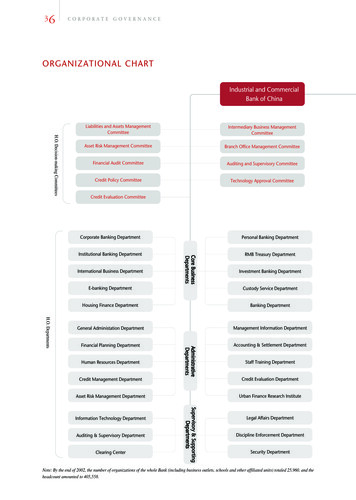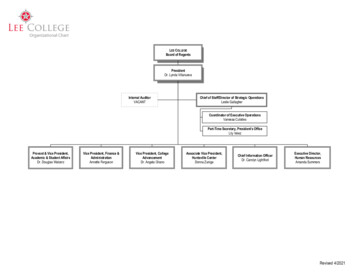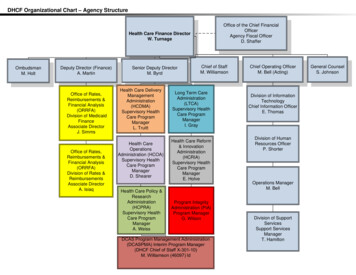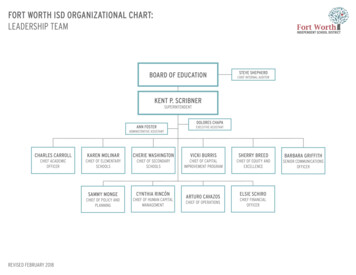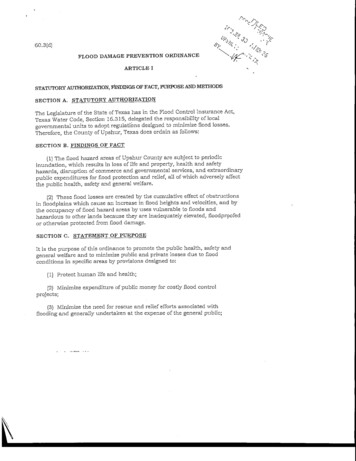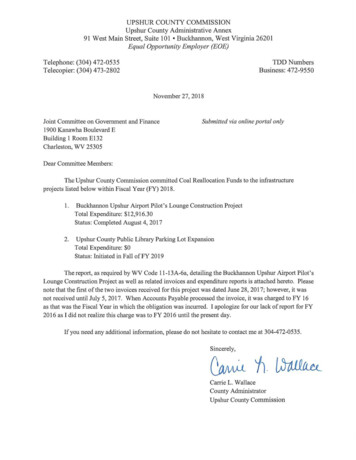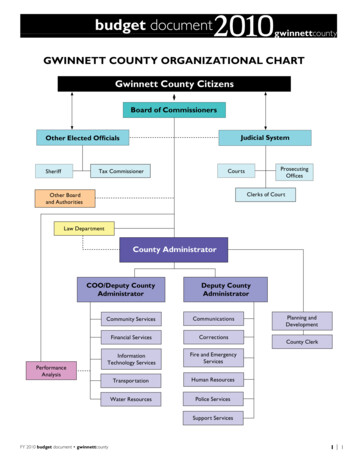
Transcription
budget documentgwinnettcountyGWINNETT COUNTY ORGANIZATIONAL CHARTGwinnett County CitizensBoard of CommissionersJudicial SystemOther Elected OfficialsProsecutingOfficesCourtsTax CommissionerSheriffClerks of CourtOther Boardand AuthoritiesLaw DepartmentCounty AdministratorCOO/Deputy CountyAdministratorPerformanceAnalysisDeputy CountyAdministratorCommunity ServicesCommunicationsFinancial ServicesCorrectionsInformationTechnology ServicesFire and EmergencyServicesTransportationHuman ResourcesWater ResourcesPolice ServicesPlanning andDevelopmentCounty ClerkSupport ServicesFY 2010 budget document gwinnettcountyI 1
budget documentDepartment DirectorsgwinnettcountyCounty AdministratorGlenn StephensHuman ResourcesKenneth Poe, DirectorCounty AttorneyKaren ThomasInformation Technology ServicesJohn Matelski, DirectorCommunity ServicesPhil Hoskins, DirectorPlanning and DevelopmentBryan Lackey, Acting DirectorCorrectionsDavid Peek, WardenPolice ServicesChief Charles M. WaltersFinancial ServicesAaron J. Bovos, DirectorSupport ServicesSteve North, DirectorFire and Emergency ServicesChief Bill MyersTransportationBrian Allen, DirectorWater ResourcesLynn Smarr, Acting DirectorElected OfficialsClerk of CourtTom LawlerDistrict AttorneyDaniel J. PorterChief Magistrate Court JudgeGeorge F. Hutchinson IIIProbate Court JudgeWalter J. Clarke Jr.SheriffR.L. “Butch” ConwaySolicitorRosanna SzaboTax CommissionerKatherine L. MeyerJudicially AppointedOfficialsJuvenile Court JudgesRobert V. Rodatus, Presiding JudgeStephen E. FranzénRobert WalkerState Court JudgesRobert W. Mock Sr., Chief JudgePamela D. SouthJoseph C. IannazzoneCarla E. BrownRandolph G. RichJohn F. Doran Jr.Superior Court JudgesK. Dawson Jackson, Chief JudgeMichael C. ClarkMelodie Snell-ConnerDebra K. TurnerWilliam M. Ray IIIR. Timothy HamilRonnie K. BatchelorThomas N. Davis Jr.Warren P. DavisKaren E. BeyersHomer M. Stark, Senior JudgeClerk of Recorder’s CourtJeff C. WestCourt AdministratorPhilip M. BoudewynsRecorder’s Court JudgesRobert S. Jones, Chief JudgeMichael GreenePatti MuiseI 2FY 2010 budget document gwinnettcounty
budget documentDepartment ofFinancial ServicesgwinnettcountyAaron J. BovosDirectorMaria WoodsDeputy DirectorCasey SnyderDeputy Directoraccounting/gl divisionRandy Colvin, DirectorCharles Collins, Budget ManagerJoe Johnson, Financial AnalystDana Brunson, Financial AnalystShirley Roper, Budget AssistantGovernment FinanceOfficers AssociationStatementThe Government Finance Officers Association of the United States and Canada (GFOA)presented an award of Distinguished Budget Presentation to Gwinnett County, Georgia for its annual budget for the fiscal year beginning January 1, 2009.In order to receive this award, a governmental unit must publish a budget documentthat meets program criteria as a policy document, as an operations guide, as a financial plan, and as communications device.The award is valid for a period of one year only. We believe our current budget continues to conform to program requirements, and we are submitting it to GFOA todetermine its eligibility for another award.FY 2010 budget document gwinnettcountyI 3
budget documenthistorygwinnettcountyCovering 437 square miles of frontier land the Creek and Cherokee Indians ceded tothe state, Gwinnett County was named after Button Gwinnett, one of Georgia’s threesigners of the Declaration of Independence. The Georgia Legislature created GwinnettCounty on December 15, 1818.In 1819, the home of Elisha Winn, one of Gwinnett’s early leaders instrumental in thecreation of the county and in whose parlor the early planning took place, became thefirst county courthouse. The first elections were held in the parlor, and superior courtproceedings were conducted in his barn, while the first jail stood nearby. Winn selectedLawrenceville as the site for the county seat and donated the land for the first permanent courthouse, which was completed in 1824 for 4,000. When it was destroyedby fire in 1871, a second courthouse was constructed in 1872, but was torn down in1884 when it was deemed inadequate. It was finally replaced in 1885 with the buildingnow known as the Historic Courthouse and was used as the county’s courthouseuntil 1988, when the construction on the Gwinnett Justice and Administration Centerwas completed.In 1914, a portion of Gwinnett was joined with parts of Walton and Jackson Countiesto form Barrow County. More of Gwinnett’s land area was lost in the mid-1950s withthe construction of Buford Dam. As the Chattahoochee River was backed up behindthe new dam, the water of Lake Lanier covered hundreds of acres.populationFor 2009, Gwinnett’s population was an estimated 808,167. Based on projections,Gwinnett is expected to reach over one million by the year 2026.public safetyThe Department of Corrections is housed in the Comprehensive Correctional Complex,an 800-bed complex that contains 512 beds for medium- and minimum-security stateand county inmates. This complex also contains 288 work release program beds fornon-violent criminal offenders and parents who fail to pay court-ordered child support.Gwinnett County’s Department of Police Services is a nationally accredited agency withan authorized strength of 803 sworn officers, supported by 316 non-sworn officers providing law enforcement services to the county. The Police Annex/E-911center openedin December 2009.Gwinnett County’s Department of Fire and Emergency Services covers one of the largest demographic areas in the state of Georgia. Serving this area with fire protection andemergency medical services is the mission of the department. The department meetsits challenge with an authorized force of 850 well-trained men and women who are proactive in their approach to the challenges and citizen-oriented in their focus. Fire Station 7in Duluth opened in March 2009. Fire Station 18 in Hamilton Mill, Fire Station 29 nearBraselton and Fire Station 30 in Loganville plan to open in late 2010.transportationGwinnett County’s infrastructure includes more than 2,750 miles of roads, which includemore than 655 signalized intersections. The 2010 Capital Budget and 2011 – 2015 planfor the Transportation Capital Improvement Program (CIP) totals over 400 million.Construction continues on the Sugarloaf Parkway Extension from SR 20/Grayson Highway to SR 316/University Parkway, east of Lawrenceville. Construction of Section OneI 4FY 2010 budget document gwinnettcounty
budget documentgwinnettcounty(Grayson Highway to New Hope Road) was completed and opened to traffic onFebruary 2, 2010. Construction on Section Two (New Hope Road to Martins ChapelRoad/Bramlett Shoals Road) began in 2009 and is anticipated to be open to trafficin 2011. The Board of Commissioners awarded construction of Section Three A inDecember, 2009.Briscoe Field is the sixth busiest airport in the state, located on approximately 500acres. It is capable of handling all light, general aviation and most corporate jet aircraft. Two fixed base operators provide excellent service and three flight schoolsprovide instruction.Gwinnett County Transit operates local bus service Monday through Saturday. FiftyExpress Buses operate weekdays during peak travel times. The six express routes allowindividuals to park their cars at central locations and take transit to destinations indowntown and midtown Atlanta. In 2009, the Transit system transported more than2.3 million people on express and local buses.educationGwinnett County Public Schools is the largest school system in Georgia and the 16thlargest school system in the country with a growth rate of 1,600 new students eachyear. Total enrollment for 2009-2010 was approximately 158,900 including students in72 elementary schools, 24 middle schools, 18 high schools, and 9 other educationalfacilities. The average cost to educate a student is 8,244 per year. Gwinnett’s schoolsystem serves over 180,000 meals daily and operates over 1,800 school buses thattravel more than 24 million miles annually. An average of 120,880 students are transported twice daily. In fiscal year 2010, the total operating budget is 2 billion dollars.There are more than 35 private schools in Gwinnett, and the City of Buford operatesits own public school system.Gwinnett is also home to several universities, such as DeVry Institute of Technology,Shorter College, Gwinnett Technical College, Georgia Perimeter College, and GeorgiaGwinnett College (partnered with The University of Georgia).Georgia Gwinnett College opened its doors as a four-year college in fall 2007. Priorto that, the College only offered a two-year associate degree. The first Georgia Gwinnett College graduation was held in June 2008. Currently, enrollment stands at 3,400but is expected to increase to 5,000 by Fall 2010.In May 2008, The University of Georgia moved its Gwinnett programs from the campus it currently shares with Georgia Gwinnett College to its new location near SugarloafParkway and I-85. Although the last class of UGA undergraduates students in Gwinnettgraduated in the Spring of 2008, enrollment in the graduate programs continues toexpand, as well as the number of programs offered. Last summer UGA launched itsfirst PhD program in Counseling Psychology.Established in 1935, the Gwinnett County Library System has grown to 14 full-servicebranches. Construction on the Hamilton Mill Branch Library began in 2008. It will bethe 15th branch library and the County’s third “green” building. The library is scheduledto open in the Spring of 2010.FY 2010 budget document gwinnettcountyI 5
budget documentbusiness environmentGwinnett CountyTop 10 Major EmployersCompanyEmployeesGwinnett County PublicSchool System20,662Gwinnett CountyGovernment4,871Gwinnett Health Care System4,365Wal-Mart3,368Publix*2,928State of Georgia2,037United States Postal Service1,969Kroger*1,880Cisco (previously Scientific Atlanta) 1,750Primerica1,543*Based on full-time equivalent (FTE)Source: Calls to individual companies – March 2010recreation and artsgwinnettcountyGwinnett County has maintained its AAA rating from all three major credit rating agenciessince 1997. The County’s favorable rating indicates solid financial management and resultsin significant interest savings for our citizens.Gwinnett County issued 22,951 occupation tax certificates (business licenses) in 2009.Gwinnett’s hospitality and international sophistication, along with affordable real estateand a well-educated labor pool, continues to attract a comprehensive array of diversecompanies.The retail market in Gwinnett offers citizens the choice of Gwinnett Place Mall, theMall of Georgia, or Discover Mills, each bringing a different type of shopping experienceto Gwinnett.In 1984, Gwinnett Place Mall became the first mall in Gwinnett and is located at I-85 andPleasant Hill Road. With anchor stores of Macy’s, JCPenney, Sears, and Belk. Gwinnett Placehas over 130 stores.The Mall of Georgia opened in 1999 and is located on Highway 20 near Buford. The mallis anchored by several major retailers such as Macy’s, Dillard’s, Nordstrom, JCPenney, Belk,and Dick’s Sporting Goods. It encompasses more than two million square feet, has morethan 200 shops, a 20-screen movie theatre with IMAX 3-D, and a village area with aninteractive fountain and outdoor pavilion, which is used for free concerts and other eventsfor patrons to enjoy throughout the year.Discover Mills opened in November 2001 and is located at the junction of I-85/Highway 120 and Sugarloaf Parkway. It is a 1.1 million-square-foot, market-dominant retailand entertainment destination featuring 14 anchors, including Bass Pro Shop’s OutdoorWorld and Neiman Marcus Last Call. There are also more than 170 specialty retailers,as well as a variety of theme restaurants, casual dining, and cutting-edge entertainment venues such as Dave & Busters, Spaha Skatepark, an 18-screen movie theater,and the Medieval Times dinner theater.The Operations Division of Gwinnett Parks and Recreation offers something for everyone from taking a yoga class, learning how to make pottery, or joining in a pick-up basketball game. They also manage facility rentals and work with Gwinnett’s 24 youth athleticassociations to offer sports like baseball/softball, basketball, cheerleading, football, soccer,roller hockey, flag football, lacrosse, and other youth sports. In 2009, the division offeredover 6,660 classes, summer camps, and special events.Gwinnett Parks and Recreation operates 44 parks and facilities that include 151 athleticfields, 51 tennis courts, 18 multi-purpose sports courts, 17 swimming pools, five dog parkareas, trails, outdoor skate complexes, playgrounds, picnic areas, pavilions, fishing lakes,and more. In 2009, Alexander, Freeman’s Mill, Harbins, Rocks Springs and Settles Bridgeparks opened.Gwinnett County continues to place a high priority on greenspace acquisition and itspark construction program. As of 2009, the total parkland acreage grew to 8849 acresfor both passive and active parks.The Gwinnett Center consists of a convention center, 702-seat performing arts center,13,000-seat arena, and a grand ballroom. Beautiful landscaping and on-site parkingmake a visit to any of these facilities enjoyable.I 6FY 2010 budget document gwinnettcounty
budget documentgwinnettcountyA 50,000-square-foot exhibit hall anchors the Convention Center. This facility also has23 meeting rooms that can accommodate up to 1,000 attendees. The Grand Ballroomis also located in the Convention Center and is a spacious 21,600 square feet.The Arena continues to be home to the Gwinnett Gladiators of the East Coast HockeyLeague. Included in the facility design are 36 corporate suites, wider seats, high-endsound, and versatile lighting. This facility can be a venue for Broadway shows, sportingevents, music concerts, and many other types of entertainment.A 19 million parking deck was completed May 21, 2009, providing six tiers of parkingand 950 spaces for Arena patrons.The AAA Br
Pleasant Hill Road. With anchor stores of Macy’s, JCPenney, Sears, and Belk. Gwinnett Place has over 130 stores. The Mall of Georgia opened in 1999 and is located on

